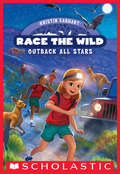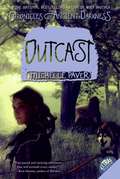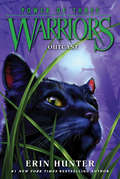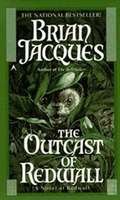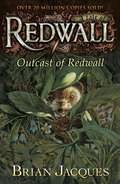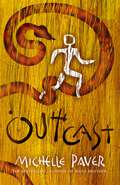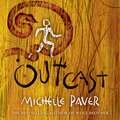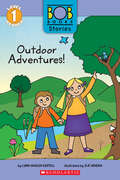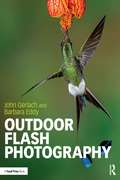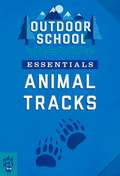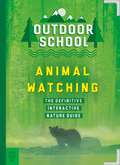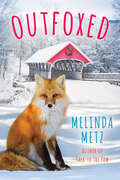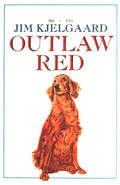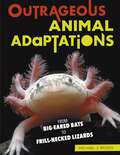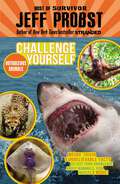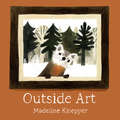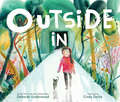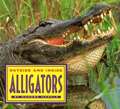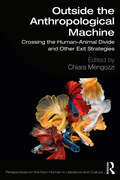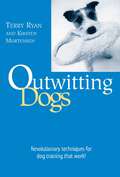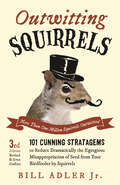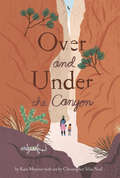- Table View
- List View
Outback All-Stars (Race the Wild #5)
by Kristin EarhartOn a once-in-a-lifetime race through the animal kingdom, it takes smarts, strength, and skill to win!It's an all-star Australian showdown!G'day mate! The team is back, and they're racing against the best of the best in the land of kangaroos, koalas, and creeping snakes. But when an old opponent appears, Sage fears it could ruin their chances. They need to be on their game if they want to win the battle of the Outback. Will the team go down in the race down under?Each chapter in this action-packed adventure series is bursting with totally true facts about wild and wonderful creatures, dangerous habitats, maps, and more!
Outcast (Chronicles of Ancient Darkness #4)
by Michelle PaverFilled with riveting adventure and heartrending scenes, "Outcast" is another thrilling story of friendship, survival, and the powerful need to belong.
Outcast (Warriors: Power of Three #3)
by Erin HunterThere will be three, Kin of you kin.... Who hold the Power of the stars In their paws. A secret prophecy shapes the lives of Firestar's grandchildren, but only one of the three knows about it. Jaypaw is captivated by the power it promises, and he believes the key to that power may lie buried in the distant past -- with the ancient cats who once walked these woods and now prowl through his dreams. His search for answers leads him toward the mountains -- the home of the Tribe of Rushing Water. Lionpaw and Hollypaw feel drawn to the mountains too, for different reasons. But the mountains hide secrets as well as answers, and if the three cats find a way to get there, they may discover more than they ever expected.
Outcast of Redwall (Redwall, Book #8)
by Brian JacquesWhen ferret Swartt Sixclaw and his arch enemy Sunflash the Mace swear a pledge of death upon each other, a young creature is cruelly banished from the safety of Redwall. As he grows, he seeks revenge on the people of Redwall and finds himself embroiled in a hostile battle with far-reaching consequences.
Outcast of Redwall: A Tale from Redwall
by Brian JacquesWhen ferret Swartt Sixclaw and his arch enemy Sunflash the Mace swear a pledge of death upon each other, a young creature is cruelly banished from the safety of Redwall. As he grows, he seeks revenge on the people of Redwall and finds himself embroiled in a hostile battle with far-reaching consequences.
Outcast: Book 4 (Chronicles of Ancient Darkness #4)
by Michelle PaverA boy. A wolf. A legend for all time. The fourth book in the internationally bestselling WOLF BROTHER (Chronicles of Ancient Darkness) series by renowned author Michelle Paver.Cast out from the clans and hunted by all, Torak is on the run. Cut off even from Wolf and Renn, he takes refuge in unknown territory - the haunted reedbeds of Lake Axehead, where he is menaced by the Hidden People. But other threats lurk nearby and his battle with the Soul-Eaters is far from over ...As he fights for his life, Torak uncovers a deception too awful to contemplate, one that shakes him to the core and shatters the world as he knows it.Audio edition also available, read by Sir Ian McKellen.
Outcast: Book 4 (Chronicles of Ancient Darkness #4)
by Michelle PaverA boy. A wolf. A legend for all time. The fourth book in the internationally bestselling WOLF BROTHER (Chronicles of Ancient Darkness) series by renowned author Michelle Paver.Cast out from the clans and hunted by all, Torak is on the run. Cut off even from Wolf and Renn, he takes refuge in unknown territory - the haunted reedbeds of Lake Axehead, where he is menaced by the Hidden People. But other threats lurk nearby and his battle with the Soul-Eaters is far from over ...As he fights for his life, Torak uncovers a deception too awful to contemplate, one that shakes him to the core and shatters the world as he knows it.Audio edition also available, read by Sir Ian McKellen.
Outcast: Book 4 from the bestselling author of Wolf Brother (Chronicles of Ancient Darkness #4)
by Michelle PaverA boy. A wolf. A legend for all time. The fourth book in the internationally bestselling WOLF BROTHER (Chronicles of Ancient Darkness) series by renowned author Michelle Paver. Audio edition read by Sir Ian McKellen.Cast out from the clans and hunted by all, Torak is on the run. Cut off even from Wolf and Renn, he takes refuge in unknown territory - the haunted reedbeds of Lake Axehead, where he is menaced by the Hidden People. But other threats lurk nearby and his battle with the Soul-Eaters is far from over ...As he fights for his life, Torak uncovers a deception too awful to contemplate, one that shakes him to the core and shatters the world as he knows it.
Outdoor Adventures! (Scholastic Reader, Level 1)
by Lynn Maslen KertellCelebrate the great outdoors in this Scholastic Level 1 Reader from the creators of the beloved Bob Books® learn-to-read phonics box sets. Perfect for reading alongside the Stage 3 Bob Books box sets, or for any child reading at Guided Reading Level G.Jack and Anna go on a hike. They duck under trees, hop over streams, and see many animals along the way. They wish they could go on a hike the next day, too, but Mom says no. Can they have their own outdoor adventure in their backyard?Bob Books Stories include:Words that children can sound out (decode); both short and long vowelsSight wordsSimple sentence structuresSimple, colorful, friendly illustrations that support children’s reading and add fun!Longer stories than the books in the Bob Books box sets, which helps children build reading enduranceBob Books has been helping children learn to read through simple phonics and playful text and illustrations for more than forty years. Your child will soon join the millions of happy kids who say, “I read the whole book!”®
Outdoor Flash Photography
by John Gerlach Barbara EddyMaximizing the power of your camera’s flash is difficult enough in a studio set-up, but outdoors literally presents a whole new world of challenges. John Gerlach and Barbara Eddy have taken the most asked about subject from their renowned photography workshops and turned it into this guidebook that is sure to inspire your next outdoor shoot, while also saving you time and frustration. Outdoor Flash Photography covers a range of practices from portrait to landscape, including unique strategies that the authors have pioneered through 40 years in the field. Mastering the use of multiple flashes to freeze action is shown through one of most challenging subjects in nature, hummingbirds in flight. This book will benefit photographers of all experience levels who are eager to evolve their outdoor photography and get the most out of their equipment.
Outdoor School Essentials: Animal Tracks (Outdoor School)
by Odd DotOUTDOOR SCHOOL ESSENTIALS: ANIMAL TRACKS is your must-have companion to the wild. These pocket-sized books from Odd Dot have quick references for what you need to know while on your next outdoor adventure.Flip through for simple diagrams and full-color illustrations on animal, reptile, and fish spotting, animal tracks, and so much more.Made of durable Tyvek material, these books are meant to last through any adventure! Waterproof and tear-proof makes these the perfect pocket-sized trove of information for kids to take outside. They're also 100% washable and 100% fun!Easy to digest at a glance, these travel-friendly books are made even more beautiful with full-color, vintage-inspired art and highly visual diagrams.
Outdoor School: The Definitive Interactive Nature Guide (Outdoor School)
by Mary Kay CarsonRewild your life! With metal corners and 448 full-color, highly illustrated pages, OUTDOOR SCHOOL: ANIMAL WATCHING is an indispensable tool for young explorers and animal lovers.Make every day an adventure with the included:- Immersive activities to get you exploring- Write-in sections to journal about experiences- Next-level adventures to challenge even seasoned nature loversNo experience is required—only curiosity and courage. This interactive field guide to animals includes:- Animal tracking- Identifying birds by silhouette, size, and color- Reading animal range maps- Bird nest spotting- Essential animal-watching gear- Identifying mammals- Bird calls and animal sounds- Finding amphibians, reptiles, and fish- Spotting scat- Recognizing eyeshine- Recording animal behaviorAnd so much more!
Outfoxed (A Fox Crossing, Maine Novel #3)
by Melinda MetzA charming small town that&’s home to a quirky assortment of characters—and one very special fox—is the setting for this uplifting story of second chances and new beginnings from beloved author Melinda Metz. The town of Fox Crossing, Maine, has something special—a legendary fox with a knack for bringing fortune, love, and happiness to anyone lucky enough to see it. . . .THESE TOWNSFOLK MAY THINK THEY&’RE PRETTY SMART Victoria Michaud has lived in Fox Crossing her entire life without encountering the fabled fox. And then, on the day of her thirtieth birthday, she spots a beautiful, golden-eyed vixen . . . right before she also recognizes Bowen Gower, the guy who made her high school years hell. So much for good luck. Victoria already has enough to deal with, between running her Junk & Disorderly antique store and refereeing her divorced, still-bickering parents.BUT IT TAKES A SLY FOX TO SHOW THEM THE WAY There are a lot of things Bowen doesn&’t remember about growing up in this town on the Appalachian trail, and some he&’s chosen to forget. Back to settle his grandfather&’s estate, Bowen soon realizes it won&’t be easy to make amends to those he wronged. But he&’s eager to convince Victoria to give him another chance. It&’ll take some doing—and perhaps more luck than one fox sighting can provide. Then again, sometimes one look is all you need . . . Praise for Melinda Metz&’s Talk to the Paw "Filled with romance and adorable kitty antics . . . a light and cozy read that is awesome to curl up with, particularly alongside your own mischievous cat!&”—Modern Cat &“Surpassingly cute story of a matchmaking cat determined to pair off his human with a neighbor through the power of stinky laundry.&” —Kirkus Reviews
Outfoxed: A Wish Novel
by Elise McMullen-CiottiFrom the author of Hedge Over Heels comes another irresistible story featuring family, friendship, and an adorable baby fox!Twelve-year-old Skye has just rescued a baby fox she’s named Kitkat, with the help of her Park Ranger cousin Braeden. Skye would usually release the fox back into the wild as soon as it’s healed, but this baby fox was injured by a trap. No one hurts a baby animal and gets away with it as long as Skye’s around, and now she’s on a mission to find the poacher!When Skye takes Kitkat to the vet, she meets a quiet girl named Ivy. To Skye’s surprise, Ivy decides to join in on the investigation and a friendship starts to form between the girls. But will these new friends uncover the true identity of the poacher and safely release Kitkat back into the wild?
Outlaw Red: Son of Big Red (Famous Dog Stories)
by Jim KjelgaardFrom pampered champion... to hunted beast! Irish setter Sean, son of Big Red, is hurled from a moving truck into wilderness where kill-or-be-killed is the pitiless law of life. Now he must match savagery for savagery... forget he has ever been tame! And yet there comes the agonizing call of old friendships. Can Red "reform"? Or is he doomed to be an outlaw, running and hiding for the rest of his life?
Outrageous Animal Adaptations: From Big-Eared Bats to Frill-Necked Lizards
by Michael J. RosenA fish that walks on land, a frog that makes its own sunscreen, and an insect that can become invisible? Whether to avoid predators, to stalk prey, or to withstand extreme temperatures, Earth's creatures have evolved some outrageous features and tricks to ensure survival. For example, did you know that the geoduck (nope, it's not a duck, it's a clam) can live as long as 160 years? And that the aye-aye, a nocturnal primate, uses echolocation and a long, spindly finger to find and dig up food? Or that in its deep-ocean habitat, the vampire squid uses bioluminescence to startle predators? These are among the many animals that show evolution and adaptation at work.
Outrageous Animals (Challenge Yourself #1)
by Jeff ProbstCHALLENGE YOURSELF! A new nature-based trivia series with vibrant visuals and fascinating facts! Discover all sorts of amazing creatures in this colorful book about animals! New from Emmy-Award winning host of Survivor and New York Times bestselling author of Stranded, Jeff Probst comes a dynamic and graphic line of trivia books! Packed with full-color photos, fascinating facts and trivia, and great callouts from Jeff, this series is perfect for every kid looking to know the coolest, weirdest facts and trivia around!Challenge yourself to discover the world&’s most amazing creatures! From black widow spiders to hammerhead sharks and everything in between, find out all the fascinating facts about animals that roam the land and sea.
Outside Art
by Madeline KloepperJoin a curious pack of woodland animals as they try to understand what art is and create their own in this beautiful, playful picture book.Pine Marten loves watching Human doing peculiar things in its log nest in the woods. One day, she notices Human putting colors on a board using a furry stick. Pine Marten learns from Chickadee that Human is actually "an artist" and is busy "making art." But what is art? Soon all of the animals in the forest are wondering: why is Human doing this? Is it a warning? Is it looking for a mate? Is there any meaning at all? And if Human can make "art," why can't the animals do it too?Outside Art is a gorgeous and gently humorous exploration of art, creativity and nature by up-and-coming author-illustrator Madeline Kloepper.
Outside In
by Deborah UnderwoodA 2020 Caldecott Honor BookFrom the New York Times best-selling author behind The Quiet Book comes a mindful contemplation on the many ways nature affects our everyday lives, even when we&’re stuck inside. Five starred reviews! Perfect for fans of Joyce Sidman and Julie Fogliano, Outside In reminds emerging readers of the ways nature creates and touches our lives in homes, apartments, and cars, and is the perfect homeschooling tool to reflect on the world&’s connectedness. Outside is waiting, the most patient playmate of all. The most generous friend. The most miraculous inventor. This thought-provoking picture book poetically underscores our powerful and enduring connection with nature, not so easily obscured by lives spent indoors. Rhythmic, powerful language shows us how our world is made and the many ways Outside comes in to help and heal us, and reminds us that we are all part of a much greater universe. Emotive illustrations evoke the beauty, simplicity, and wonder that await us all . . . outside.
Outside and Inside Alligators
by Sandra MarkleHow can an alligator swim swiftly with its short, stubby legs? How can it open its big mouth and grab prey underwater without getting water in its lungs? Why would an alligator guard a big mound of plants and mud? "Outside and Inside Alligators" answers these questions and many others. With stunning color photographs of developing alligator babies as well as their huge parents and with clear, accessible text, Sandra Markle invites children to learn all about these unique and fascinating creatures. Curious young readers will delight in this close look at alligators -- from the inside out!
Outside the Anthropological Machine: Crossing the Human-Animal Divide and Other Exit Strategies (Perspectives on the Non-Human in Literature and Culture)
by Chiara MengozziIn the midst of the climate crisis and the threat of the sixth extinction, we can no longer claim to be the masters of nature. Rather, we need to unlearn our species’ arrogance for the sake of all animals, human and non-human. Rethinking our being-in-the-world as Homo sapiens, this monograph argues, starts precisely from the way we relate to our closer companion species. The authors gathered here endeavour to find multiple exit strategies from the anthropocentric paradigms that have bound the human and social sciences. Part I investigates the unexplored margins of human history by re-reading historical events, literary texts, and scientific findings from an animal’s perspective, rather than a human’s. Part II explores different forms of human-animal relationships, putting the emphasis on the institutions, spaces, and discourses that frame our interactions with animals. Part III engages with processes of "translation" that aim to render animals’ experience and perception into human words and visual language.
Outsmarting Cats: How to Persuade the Felines in Your Life to do What You Want
by Wendy ChristensenWhile cat owners adore their purring, fuzzy friends, cats can have another, rather unpleasant, side. Some pee on carpets, shred upholstery, chomp houseplants, caterwaul at all hours, and scratch and bite. Skeptics will claim that it’s impossible to train a cat. Happily, Wendy Christensen knows they’re wrong. True, cats are intelligent, adaptable, patient, independent, stubborn, observant, and extremely quick learners. But they're also remarkably self-interested and quick to exploit a good deal. Outsmarting Cats enables you to persuade your cat that what you want is also what she wants. Whatever your specific cat problem, Wendy Christensen gives all the latest information on what works, and what doesn't. She shares tried-and-true tips and resources for resolving even the thorniest behavior problems. And she'll tell you how to head off future problems, simply by understanding how your cat thinks.
Outwitting Dogs (Outwitting)
by Terry Ryan Kirsten MortensenTraining dogs has traditionally been done by using negative reinforcement and brute force (take the choke collar as an example). But the tide is turning, and Terry Ryan, well-known dog trainer, is at the forefront of a revolution. OUTWITTING DOGS draws on her twentyfive years of hands-on experience helping people understand and train dogs, and solve dog behavior problems using kinder, gentler methods. OUTWITTING DOGS uses more brain than brawn to motivate dog behavior with positive training techniques, and helps readers truly understand the minds of their canine friends (and even enemies). Chapters cover: . outwitting puppies . housebreaking . curing the chronic chewer . how to cure the leash puller, the dog that jumps on people, the dog that hates to be left alone, the dog that won't come, the dog that barks too much, the biter, the aggressor . how to outwit the neighbor's dog . how to teach your dog tricks . how to outwit dog trainers . and even a chapter on outwitting dogs and kids at the same time, and much more. No sensible dog owner will want to be without a copy.
Outwitting Squirrels: 101 Cunning Stratagems to Reduce Dramatically the Egregious Misappropriation of Seed from Your Birdf
by Bill AdlerThe 48 million Americans of all ages who enjoy feeding wild birds and spend more than $3 billion a year on bird food alone all share a common enemy--the squirrel. For 25 years, Outwitting Squirrels has been leading the charge to help bird lovers defend their feeders from these fast, greedy, incredibly crafty creatures who pillage birdfeeders before owners' very eyes. This classic defense manual for the besieged bird feeder has been fully updated to deal with the more tech-savvy, 21st-century squirrel. It provides 101 cunning strategies, both serious and hilarious, for outsmarting these furry, but not so cute, creatures. Author Bill Adler Jr. discusses the different bird personalities and the best seed to attract them. He rates birdfeeders based upon how squirrel-proof, or squirrel-vexing they are, and discusses creative anti-squirrel structures and devices. Spooker poles, Perrier bottles, baffled fishing line, Teflon spray, Vaseline, water bombs, cayenne pepper, and Nixalite--the author has tried them all and he regales readers with his squirrel adventures and misadventures.
Over and Under the Canyon
by Kate MessnerIn this latest book in the acclaimed Over and Under series, a spectacular hike reveals the hidden wonders, rich colors, and layers of wildlife living within a thriving desert slot-canyon.Over and Under the Canyon takes young readers on a thrilling tour of a desert canyon ecosystem. Over the canyon, the sun scalds the air, baking desert mud to stone. But under the shade of the cliffs hides another world, where bighorn sheep bound from rock to rock on the hillside, roadrunners make their nests in sturdy cacti, and banded geckos tuck themselves into the shelter of the sand. Discover the wonders concealed in the curves of the canyon, the magic of a desert wildflower bloom, and all the unexpected creatures that bring the desert to life.DISCOVER AMAZING ANIMALS: Kids are endlessly curious about the natural world and the wildly varied animals living in it—and the desert is FULL of amazing and surprising animals!CAPTIVATING NONFICTION: Like its predecessors, this latest offering in the Over and Under picture book series illuminates the magic of the natural world and its amazing inhabitants by telling the story of one family's hike through a real-world desert ecosystem in lyrical prose and color-drenched illustrations. Even the most reluctant readers will be drawn into a fact-filled story this compelling!GREAT FOR TEACHING: The Next Generation Science Standards (NGSS) emphasize learning about animal habitats/biomes in K–2 curriculums, while later grades address topics like food chains, conservation, and endangered species. With a depth of research and an engaging, highly visual narrative, this book is an excellent resource for librarians and primary school educators.ENCOURAGES ENVIRONMENTAL AWARENESS: Concern for and preservation of the wilderness is an increasingly talked-about topic. This book provides a great, upbeat jumping-off point for discussions of the importance and wonder of our world’s natural habitats and ecosystems.ACCLAIMED AUTHOR-ILLUSTRATOR TEAM: Kate Messner is an award-winning author whose books for kids have been New York Times Notable, Junior Library Guild, IndieBound, and Bank Street College of Education Best Book selections. In addition to his work on this acclaimed series, Christopher Silas Neal is an award-winning illustrator and author who regularly contributes to the New York Times and The New Yorker, and he has been awarded a medal from the Society of Illustrators.Perfect for:• Parents• Nature lovers• Fans of Kate Messner• Fans of Over and Under the Snow and previous books in the series• Educators and librarians seeking nonfiction books with STEM content
